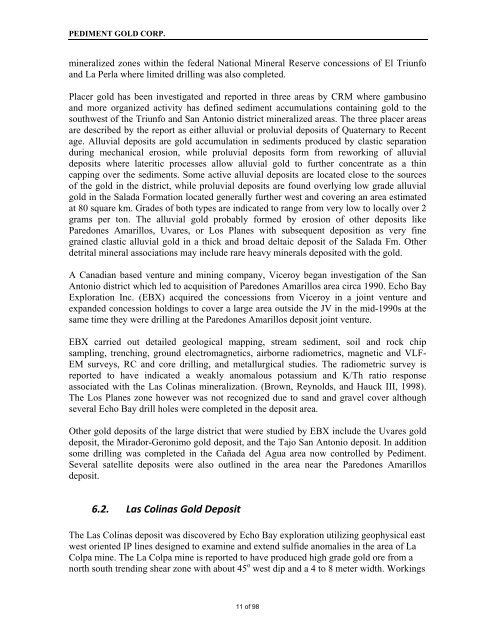43-101 2009 Technical Report On The San Antonio Project, Baja ...
43-101 2009 Technical Report On The San Antonio Project, Baja ...
43-101 2009 Technical Report On The San Antonio Project, Baja ...
- No tags were found...
You also want an ePaper? Increase the reach of your titles
YUMPU automatically turns print PDFs into web optimized ePapers that Google loves.
PEDIMENT GOLD CORP.mineralized zones within the federal National Mineral Reserve concessions of El Triunfoand La Perla where limited drilling was also completed.Placer gold has been investigated and reported in three areas by CRM where gambusinoand more organized activity has defined sediment accumulations containing gold to thesouthwest of the Triunfo and <strong>San</strong> <strong>Antonio</strong> district mineralized areas. <strong>The</strong> three placer areasare described by the report as either alluvial or proluvial deposits of Quaternary to Recentage. Alluvial deposits are gold accumulation in sediments produced by clastic separationduring mechanical erosion, while proluvial deposits form from reworking of alluvialdeposits where lateritic processes allow alluvial gold to further concentrate as a thincapping over the sediments. Some active alluvial deposits are located close to the sourcesof the gold in the district, while proluvial deposits are found overlying low grade alluvialgold in the Salada Formation located generally further west and covering an area estimatedat 80 square km. Grades of both types are indicated to range from very low to locally over 2grams per ton. <strong>The</strong> alluvial gold probably formed by erosion of other deposits likeParedones Amarillos, Uvares, or Los Planes with subsequent deposition as very finegrained clastic alluvial gold in a thick and broad deltaic deposit of the Salada Fm. Otherdetrital mineral associations may include rare heavy minerals deposited with the gold.A Canadian based venture and mining company, Viceroy began investigation of the <strong>San</strong><strong>Antonio</strong> district which led to acquisition of Paredones Amarillos area circa 1990. Echo BayExploration Inc. (EBX) acquired the concessions from Viceroy in a joint venture andexpanded concession holdings to cover a large area outside the JV in the mid-1990s at thesame time they were drilling at the Paredones Amarillos deposit joint venture.EBX carried out detailed geological mapping, stream sediment, soil and rock chipsampling, trenching, ground electromagnetics, airborne radiometrics, magnetic and VLF-EM surveys, RC and core drilling, and metallurgical studies. <strong>The</strong> radiometric survey isreported to have indicated a weakly anomalous potassium and K/Th ratio responseassociated with the Las Colinas mineralization. (Brown, Reynolds, and Hauck III, 1998).<strong>The</strong> Los Planes zone however was not recognized due to sand and gravel cover althoughseveral Echo Bay drill holes were completed in the deposit area.Other gold deposits of the large district that were studied by EBX include the Uvares golddeposit, the Mirador-Geronimo gold deposit, and the Tajo <strong>San</strong> <strong>Antonio</strong> deposit. In additionsome drilling was completed in the Cañada del Agua area now controlled by Pediment.Several satellite deposits were also outlined in the area near the Paredones Amarillosdeposit.6.2. Las Colinas Gold Deposit<strong>The</strong> Las Colinas deposit was discovered by Echo Bay exploration utilizing geophysical eastwest oriented IP lines designed to examine and extend sulfide anomalies in the area of LaColpa mine. <strong>The</strong> La Colpa mine is reported to have produced high grade gold ore from anorth south trending shear zone with about 45 o west dip and a 4 to 8 meter width. Workings











